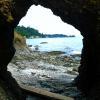January 26, 2015 - 22:42

I suppose I may be cheating a bit, since a did a project last year looking at the discharge rates for the inflow and outflow pipes on Rhoads pond, but I felt keen on focusing my exploration of campus on one specific aspect: water. While reading through the write-up on some of the geology of Bryn Mawr, I found myself intrigued by the sections on some of the hydrology of the campus. The creation of Rhoads pond and the diversion off campus into Mill Creek—through an underground pipe nonetheless—seems singular and odd. It was only instituted relatively recently, to make up for paved surfaces. My goal for my outside exploration was to trace some water. If I was a water molecule, where would I go (or be directed) on campus?
This task proved more difficult than envisioned, because I quickly realized that much of the water on campus is in the form of ice or snow at present. So some imagination was used. As I was shuffling around in the snow, I was reminded of the campus when it rains. It becomes a flooded mess. It’s odd, but ‘naturally’ flowing or pooling water is simply not a designed part of this campus. It isn’t accounted for, and so in a downpour the rainwater does what it wants by turning Merion green into a swamp or gurgling happily in the channels it chooses or turning sidewalks into floodplains. Still, I wandered from Rhoads pond towards the gym and around back of Park and Ward in the general direction of the outflow pipe. Given a warmer day, the snow and ice will eventually melt and either follow the few drainage systems in place on campus or find its own way to Mill Creek.
All the while I kept thinking about where our runoff goes. Eventually it makes it way to the Atlantic—via some smaller tributaries, then the Schuylkill, then the Delaware. And the water doesn’t just take water with it—it takes sediment and other things. It’s difficult to walk anywhere on campus without slipping on salt as well as snow. Imagine where that salt will go when the snow melts. People like to call Bryn Mawr a bubble, but as I wandered around campus, it was very clear that we are not an isolated system.
